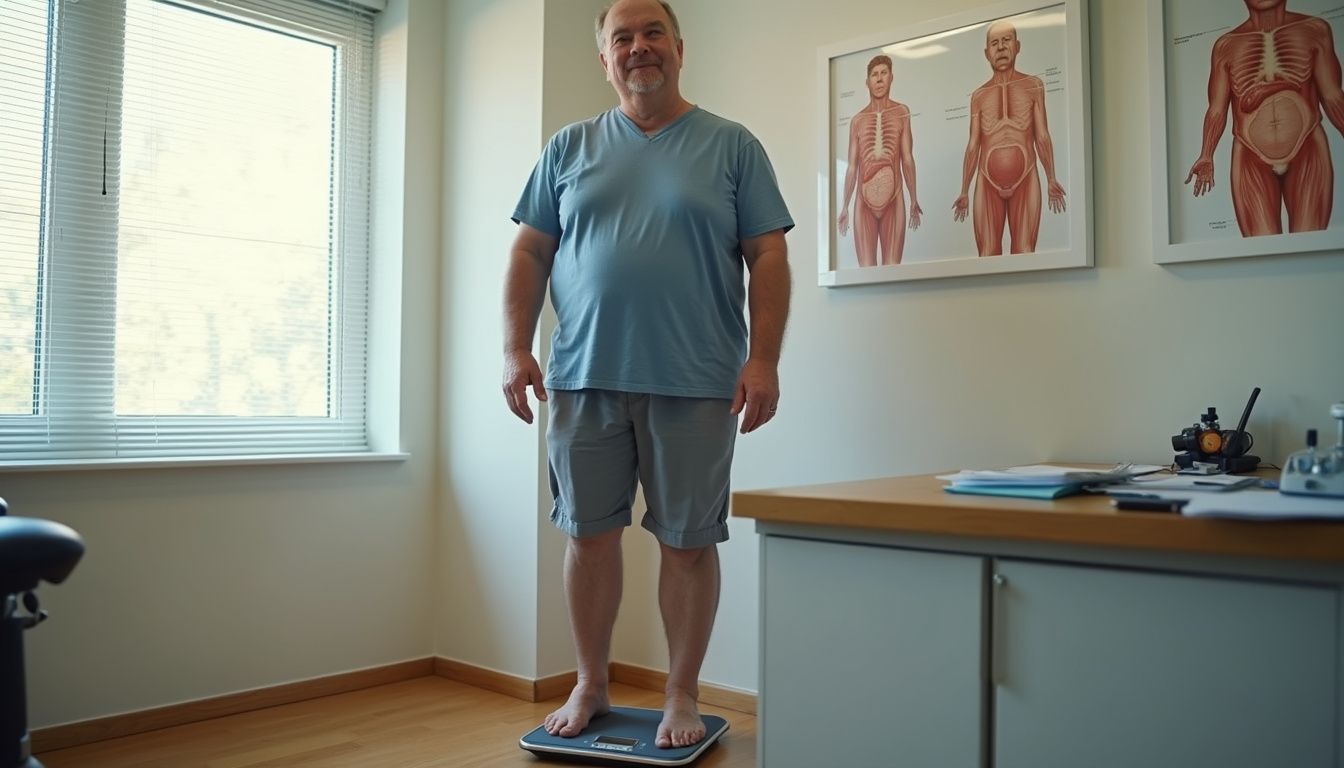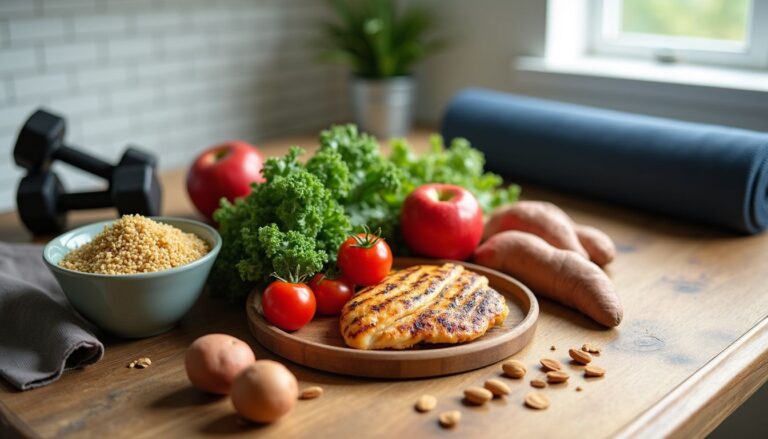Effective Ways To Lower Body Fat Quickly
Our Nutrition Assistant AI Suite will transform your body. You will lose fat, get toned, and build muscle. Gain confidence and optimal health.
If you want to lower body fat but keep stalling, you are not alone. Extra fat around the middle, called visceral fat, raises the risk of heart disease and type 2 diabetes. This guide gives you practical steps and science-backed ways to lose weight safely and see progress fast.
Use these methods to start burning fat fast and build momentum this week.
Key Takeaways
- A daily calorie deficit of 500 to 1,000 supports safe fat loss of 1 to 2 pounds per week, as most experts advise.
- Higher protein intake, about 0.8 grams per pound of body weight, and a Mediterranean eating pattern with healthy fats can reduce body fat percentage while protecting muscle mass.
- Cardio, 150 to 300 minutes weekly, plus strength training at least twice per week helps shrink visceral fat and your waistline.
- Good sleep, at least 7 hours nightly, and stress control lower the risk of visceral fat buildup, according to recent reviews on metabolic health.
- Tracking waist size and body fat percentage gives clearer feedback than BMI alone for fat loss goals.

Understanding Different Types of Body Fat and Their Impact

Body fat is not all the same. Different types affect your health in different ways. Knowing the difference helps you choose the most effective way to lose and keep weight off.
What Are Subcutaneous and Visceral Fat?
Subcutaneous fat sits right under your skin. It is the soft layer you can pinch on your arms, hips, or waist. Visceral fat lies deeper in your abdomen. It wraps around organs such as your liver and intestines and is more active metabolically.
Visceral fat cells respond strongly to stress and hormones, which can speed up fat storage and disrupt metabolism. High levels raise the risk of obesity, high cholesterol, diabetes, and plaque buildup in arteries. Certain medical issues, such as Cushing syndrome or low thyroid function, can add to visceral fat.
There is good news. Visceral fat often responds quickly to diet and regular exercise. Many people notice changes in about 2 to 3 months.
Why Should You Reduce Body Fat?
Reducing excess fat, especially around your abdomen, protects your long-term health. High visceral fat raises the risk of diabetes, heart problems, and high cholesterol.
A waist size of 35 inches or more for women, or 40 inches or more for men, signals higher risk. A waist-to-hip ratio above 0.85 for women, and above 0.90 for men, points to abdominal obesity. People with a body mass index, or BMI, of 30 or higher tend to carry more visceral fat and face more chronic conditions.
Lower fat supports healthier blood vessels and better sleep. It also improves blood sugar control. Eating whole grains, produce, lean protein, and healthy fats like olive oil can reduce abdominal fat while helping preserve muscle mass.
In my own journey, focusing on belly fat helped my energy during work and workouts.
Lowering body fat percentage isn’t only about how you look—it’s about protecting your future heart health.
Small swaps create big change. Choose nuts or seeds instead of candy, drink unsweetened beverages instead of soda, and monitor your waist size to track progress.
Dietary Strategies to Lower Body Fat
Food choices drive most fat loss. Simple, steady changes to what you eat and drink help reduce body fat percentage and support weight management.
How Does Creating a Calorie Deficit Help Reduce Fat?
A calorie deficit means you eat fewer calories than your body uses. Your body then taps stored energy, including fat, to close the gap. A daily deficit of 500 to 1,000 calories usually leads to a loss of 1 to 2 pounds per week.
Slower losses protect muscle and your resting metabolism. Tracking meals helped me keep a modest deficit and lower body fat without losing strength. Cutting sugary drinks made a fast difference because sweet beverages raise BMI and weight gain in adults and kids.
Why Follow a High Protein Diet for Fat Loss?
Protein keeps you full and shields muscle while you lose fat. Aim for about 0.8 grams per pound of body weight per day. For many adults, 10 to 35 percent of total calories from protein works well.
Research shows higher protein can reduce body fat more than low protein or high carbohydrate plans. Good sources include lean meat, fish, eggs, dairy, tofu, and beans. Protein also has a higher thermic effect, meaning your body burns more calories to digest it. My coach repeated one line often, protein helps you stay satisfied and protects your muscles.
How Can Healthy Fats Support Fat Reduction?
Healthy fats, like those in olive oil, avocados, nuts, and seeds, support appetite control. A 2023 review found a Mediterranean diet pattern, rich in unsaturated fats, helped lower body mass index and supported long-term weight loss.
Swap fried foods and refined oils for extra virgin olive oil or natural nut butters. These fats help regulate hormones involved in fat burning. They are calorie dense, so measure portions to support your deficit. Many people find a Mediterranean or plant-forward plan improves energy and makes steady fat loss easier.
What Are the Benefits of Increasing Fiber Intake?
Fiber adds bulk and slows digestion, which boosts fullness. Most adults benefit from 25 to 30 grams per day. Current guidance suggests about 28 grams daily for women and 34 grams for men.
Soluble fiber, found in oats, beans, and fruit, absorbs water and helps reduce belly fat. Insoluble fiber supports regularity. Try oats or lentils at breakfast. I felt less hungry and found it easier to stick with my plan.
Why Limit Processed and Sugary Foods?
Processed snacks often pack added sugar, refined flour, and sodium. These raise calories yet do little for fullness. Diets high in refined grains, such as white bread and pasta, are linked with more belly fat over time.
Sugar-sweetened beverages are a major source of extra calories. A 2023 review of 85 papers linked them with higher BMI in both children and adults. Choosing whole grains, nuts, and produce helps stabilize blood sugar and supports your calorie deficit.
How Does Staying Hydrated with Unsweetened Beverages Aid Fat Loss?
Replacing sweet drinks with water or unsweetened tea can cut hundreds of calories per week. Studies show that swapping sugary beverages for water lowers daily calorie intake by about 200 on average.
Good options include plain water, sparkling water, and unsweetened green tea. Add lemon, cucumber, or mint for flavor. Hydration also helps curb false hunger since thirst often feels like you need a snack.
Exercise for Effective Fat Loss
Movement acts like an accelerator for fat loss. It also preserves muscle mass while you cut calories.
What Are the Best Cardio Workouts for Burning Fat?
Cardio raises your heart rate and burns calories. Choose activities you can repeat most days.
- Running outdoors or on a treadmill builds endurance and burns many calories.
- Brisk walking is low impact and easy to start. A daily 30-minute walk supports fat loss.
- Cycling, outdoors or stationary, targets the lower body and reduces visceral fat.
- Swimming works your whole body and supports joint health.
- High-intensity interval training, or HIIT, alternates hard efforts with short rests for efficient fat burn.
- Jump rope delivers a fast calorie burn in a short session.
- Group classes, such as dance cardio or indoor cycling, make it easier to reach 150 to 300 minutes weekly.
- A 2022 review of 15 studies linked more aerobic exercise with smaller waistlines in middle-aged women.
I kept a simple log when I started running and cycling. After eight weeks of consistent cardio, my waist shrank and my energy climbed.
How Does Strength Training Help Build Muscle and Reduce Fat?
Strength training challenges your muscles with resistance. This includes free weights, machines, or bodyweight moves like squats and push-ups. More muscle raises your basal metabolic rate, so you burn more calories all day.
A 2021 review of 58 studies found that at least four weeks of resistance training reduced body fat by about 1.46 percent on average. It is especially effective for visceral fat. Aim for two sessions per week, as recommended in national guidelines.
What Is High-Intensity Interval Training (HIIT) and How Does It Work?
HIIT combines short bursts of hard work with brief recovery. For example, sprint 30 seconds, then walk 30 seconds. Repeat for 10 to 20 minutes.
A 2023 review of 36 studies showed HIIT can lower body fat percentage and improve body composition. Cycling-based HIIT works well. Try circuits with squats, push-ups, and burpees, resting between rounds. Pair HIIT with strength training for better results.
Lifestyle Adjustments for Sustainable Results
Small daily habits steady your progress. Think of them as the frame that holds your plan together.
How Does Quality Sleep Affect Body Fat?
Adults need at least 7 hours of sleep per night. Short sleep, under 6 hours, is linked with more visceral fat and higher risk of metabolic problems.
Poor sleep raises appetite and cravings for sugary foods. It also raises cortisol, a stress hormone that can promote fat storage. Set a steady bedtime, limit evening caffeine, and cut screens before bed. Once I built a consistent routine, my cravings dropped and workouts felt easier.
What Are Effective Ways to Manage Stress for Fat Loss?
Chronic stress spikes cortisol and encourages fat storage in the abdomen. Daily movement, yoga, and deep breathing lower stress hormones and help with better food choices.
Try 15 minutes of stretching or a mindful walk if your schedule is tight. After adding morning walks and a simple meditation, my snack cravings eased and I felt calmer during meals.
Why Is Avoiding Sedentary Behavior Important?
Long periods of sitting are linked with weight gain and higher risk of chronic disease. Break up sitting with short activity bursts.
Stand during calls, add short walks, or do light stretches every hour. These micro-movements raise daily calorie burn and improve body composition. Pacing during phone calls gave me a surprising energy boost.
Advanced Tips to Burn Fat Faster
Once the basics are solid, a few advanced tactics can speed results. Use them as add-ons, not replacements.
How Can Tracking Measurements Help Your Fat Loss?
Track your weight, waist size, and body fat percentage. These numbers show changes a scale alone can miss.
Healthy targets include a waist under 35 inches for women and under 40 inches for men. A waist-to-hip ratio under 0.85 for women and under 0.90 for men signals lower abdominal fat. A waist-to-height ratio under 0.5 is another good marker. Seeing steady trends helps you adjust calories or workouts faster. Clothes often fit better before the scale moves much, which is a sign of better body composition.
What Is Intermittent Fasting and Does It Work?
Intermittent fasting sets a daily or weekly pattern of eating and fasting to create a calorie deficit. The 16/8 method uses an eight-hour eating window and a sixteen-hour fast. Other formats include Eat Stop Eat or the 5:2 approach, where two days are lower in calories.
A 2024 review found intermittent fasting can reduce body fat percentage, waist size, and visceral fat. It can work well if you prefer fewer meals or a set eating window. It is not right for everyone. Some people, including some women and athletes, may see changes in hormones or performance. Check with a clinician if you have medical conditions.
How Do Probiotics Influence Fat Loss?
Probiotics are helpful bacteria that support gut health. Certain strains, including Bifidobacterium, have been linked with smaller waistlines and lower visceral fat in recent reviews.
They may not change BMI much, but they can improve body composition. Good sources include kefir, yogurt with live cultures, kimchi, sauerkraut, tempeh, and kombucha. I added kefir daily and noticed steadier appetite and better fitting clothes within weeks.
Can Drinking Coffee Boost Metabolism Safely?
Caffeine can raise metabolic rate and increase fat use during exercise. Studies show coffee may lower BMI and total fat mass, especially when paired with training.
Choose black coffee to avoid extra calories. Limit cream and sugar. I switched from flavored lattes to brewed coffee and noticed fewer cravings along with better control of calories.
Foods and Habits to Avoid
Some choices stall progress. Cut back on these items to keep your plan on track.
Which Processed Snacks and Sugary Drinks Should Be Avoided?
- Potato chips and similar fried snacks often contain unhealthy oils, sodium, and trans fats.
- Packaged pastries and cookies are high in added sugar and refined flour.
- Sugar-sweetened drinks like soda, sweet tea, energy drinks, and fruit punch drive weight gain. A 2023 review linked them with higher BMI in both kids and adults.
- Some granola bars hide syrups and sugars that can increase hunger instead of reducing it.
- Flavored yogurt snacks may act more like desserts due to added sugar.
- Candy bars pack added sugars and saturated fat with few nutrients.
- Instant noodles and many savory packaged snacks are loaded with sodium and preservatives.
- Alcoholic drinks mixed with sugary soda or juice add many empty calories.
Switch to water or other unsweetened drinks. Small changes like these lower total calories and help reduce body fat more quickly.
How Does Excessive Alcohol Impact Fat Loss?
Alcohol contains 7 calories per gram. Your body burns alcohol first, which can slow fat burning. It also lowers inhibitions, which can lead to overeating, especially late at night.
Heavy drinking is linked with more belly fat. Alcohol also strains the liver, which plays a key role in fat metabolism. I saw better workouts and fewer late-night snacks after cutting back. Track your intake and choose nonalcoholic options when possible.
Why Limit Refined Carbohydrates?
Refined grains like white bread and pastries digest fast and spike blood sugar. Diets high in refined grains are linked with more belly fat over time.
Choose whole grains such as oatmeal, brown rice, and whole wheat bread. They digest slower, keep you full longer, and provide vitamins and minerals. After replacing white bread with oatmeal at breakfast, my morning energy stayed steady until lunch.
Monitoring Your Body Composition
Good tracking shows what is working. Clear measurements help you make smarter changes.
How Do You Measure Body Fat Percentage Accurately?
Several tools measure body fat. Skinfold calipers estimate subcutaneous fat at set sites on the body. Results depend on technician skill. Bioelectrical impedance devices send a harmless current through the body to estimate fat and lean mass. DEXA scans use low-level X-rays and are very precise, though cost more and may require a clinic visit.
Waist measures are also useful. A waist of 35 inches or more for women, and 40 inches or more for men, signals higher risk. Waist-to-hip ratios above 0.85 for women and 0.90 for men point to abdominal obesity. A waist-to-height ratio above 0.5 suggests higher metabolic risk. Tracking these numbers kept me motivated while following a Mediterranean-style plan rich in vegetables, nuts, whole grains, and lean protein.
What Roles Do BMI and Waist Circumference Play in Tracking Fat?
BMI screens for overweight and obesity using height and weight. A BMI of 30 or higher is linked with more visceral fat and higher health risks. It does not show where fat is stored, which is why waist size matters.
Waist circumference reveals hidden central fat that BMI can miss. Measurements over 40 inches for men or 35 inches for women raise health risk. I recorded my waist each month and found those numbers more encouraging than the scale alone.
Additional Tools to Support Fat Loss
Smart tools and expert help add structure and accountability. Use them to personalize your plan.
How Can Fitness Trackers and Apps Help You?
Trackers and apps log steps, heart rate, workouts, and nutrition. Seeing real-time data makes it easier to keep a calorie deficit and stay active.
Goal setting, reminders, and simple charts boost motivation. A 2021 study found people using fitness tech were 27 percent more likely to hit their goals. Many apps include community support or access to coaches.
When Should You Consult a Nutritionist or Trainer?
Meet with a licensed nutritionist or certified trainer if you want a plan that fits your health history and goals. Professional guidance is especially helpful if you have diabetes, heart disease, high blood pressure, or take medications.
A dietitian can adjust a Mediterranean-style plan to your needs and preferences. I avoided misleading supplement claims after working with a nutritionist. The plan felt realistic, safe, and effective.
Common Myths About Fat Loss
Claims about fast fixes spread quickly. Knowing the facts saves you time and frustration.
Why Is Spot Reduction a Myth?
Spot reduction suggests you can burn fat from one area by training that body part. Studies do not support this. Fat loss happens across the body when you keep a calorie deficit and move regularly.
Crunches alone will not flatten your waist if total body fat remains high. Full-body cardio and resistance training, along with a healthy diet, reduce waist size and visceral fat. That approach worked best for me.
Why Are Crash Diets Unsustainable?
Crash diets slash calories too low. Metabolism slows, and you often regain the weight later. Fast losses also risk muscle loss, which lowers strength and daily calorie burn.
Safe targets are 1 to 2 pounds per week. Balanced plans, such as a Mediterranean pattern, support steady fat loss without sacrificing health. Skip extreme supplements and drastic rules.
Benefits of Lowering Body Fat
Reducing excess fat improves many parts of health. The benefits reach far beyond the mirror.
How Does Lower Body Fat Improve Heart Health?
Less visceral fat helps arteries relax and improves blood flow. A Johns Hopkins study reported better artery function with weight loss, which supports a healthier heart.
After shifting to a Mediterranean-style plan and cutting ultra-processed foods, my waist shrank and my blood pressure improved. Small, steady changes add up over time.
What Are the Effects on Energy and Physical Performance?
Lower body fat often means higher energy. Daily tasks feel easier, and recovery improves. Building lean muscle raises resting metabolism, so you burn more calories at rest.
Combining cardio and regular strength training improves stamina and power1. After trimming fat, I could run longer and felt less sore the next day.
1 Harvard Health Publishing, 2021, Strength training: Get stronger, leaner, healthier.
How Does Reducing Fat Lower Chronic Disease Risks?
Keeping a slimmer waist lowers the risk of type 2 diabetes, certain cancers, and heart disease. Visceral fat is strongly linked to high cholesterol and plaque in arteries.
Balanced nutrition, daily movement, and tracking your progress reduce long-term health risks. People with lower visceral fat often show better blood pressure and blood sugar control.
Conclusion
Quick but safe fat loss comes from a simple plan you can repeat daily. Prioritize a calorie deficit, higher protein intake, fiber-rich foods, and plenty of water. Include whole grains, produce, and healthy fats to stay full.
Train your body with both cardio and strength work. Track waist size and body fat percentage to see real progress. Sleep 7 or more hours, manage stress, and limit alcohol and sugary drinks.
This article is for education only, not medical advice. If you have a health condition, talk with your healthcare provider before major changes. With consistent habits, you can lower your body fat percentage and protect your long-term health.
FAQs
1. What are the most effective ways to lower body fat quickly?
The most effective ways include reducing calorie intake, increasing physical activity, and choosing nutrient-rich foods. Research shows that combining aerobic exercise with resistance training helps burn more fat than either alone. Eating more protein and fiber also supports fat loss by increasing satiety and preserving muscle mass.
2. How does diet impact body fat reduction?
A balanced eating plan with fewer calories than you burn leads to fat loss. Studies show that diets high in lean protein and vegetables, and low in processed foods, help reduce body fat. Tracking food intake can help identify hidden sources of calories.
3. Can exercise alone lower body fat quickly?
Exercise plays a key role, but it works best with a healthy eating plan. Data from clinical trials indicate that people who combine exercise with calorie control lose more fat than those who only exercise. Both cardio and strength training are important for optimal results.
4. What role does sleep play in reducing body fat?
Getting enough sleep is essential for fat loss. Research links poor sleep to higher body fat and increased hunger hormones. Adults who sleep at least seven hours per night tend to have lower body fat percentages.
Summary: Lowering body fat quickly requires a mix of healthy eating, regular exercise, and good sleep habits. Evidence supports combining these methods for the best results. Personal experience shows that tracking meals, staying active, and prioritizing rest make a noticeable difference in body composition.







